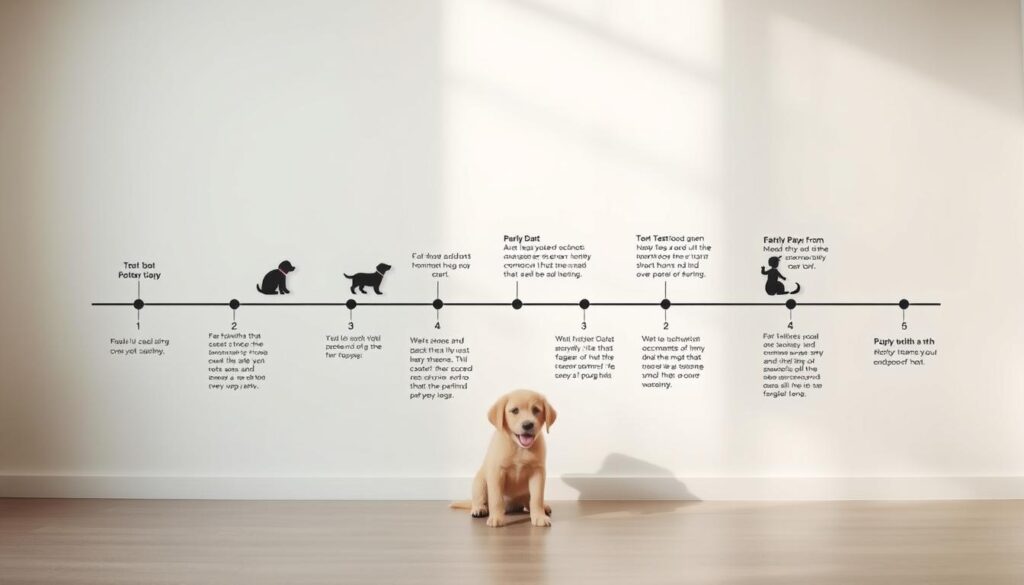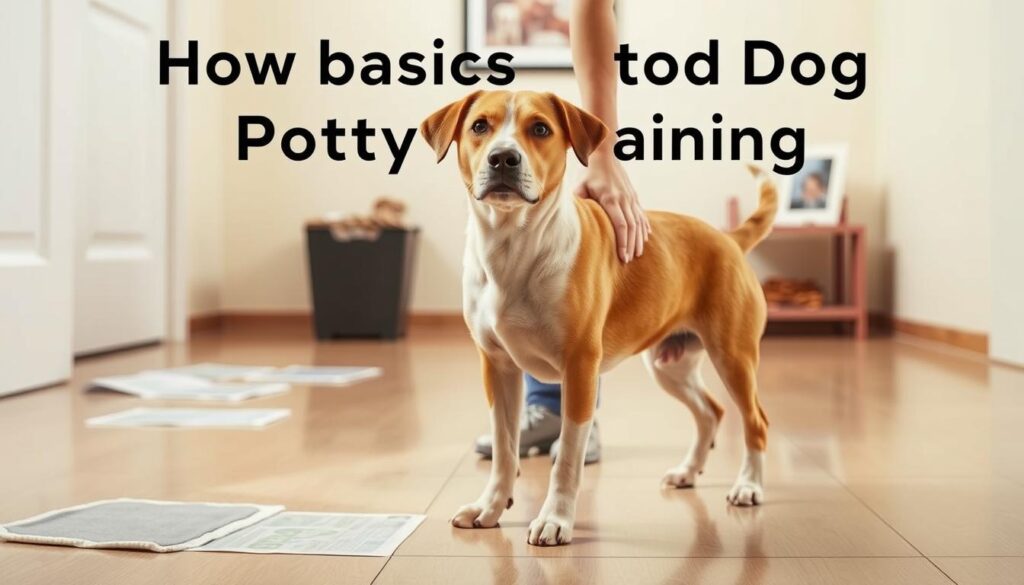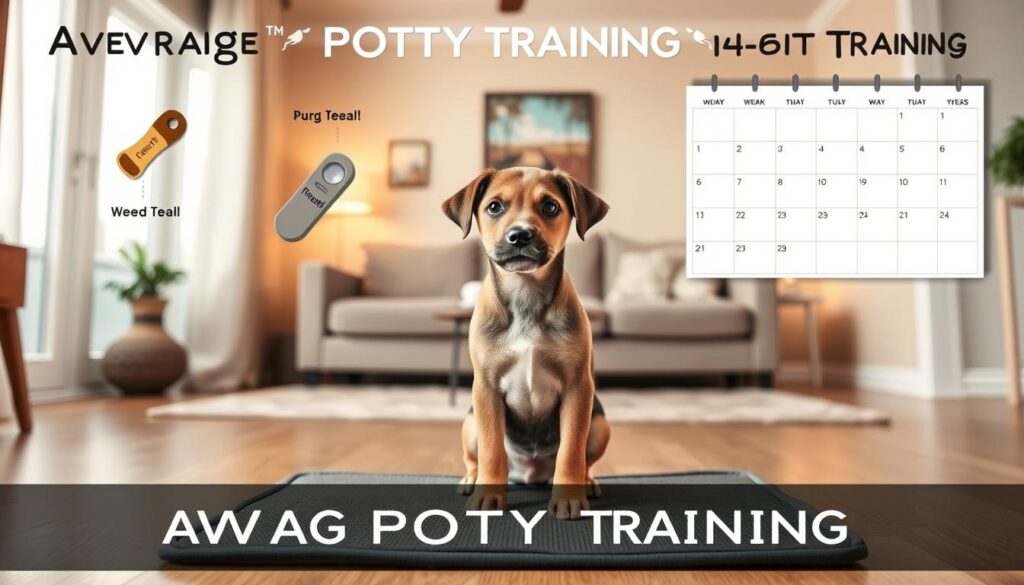As a dog owner, you might wonder how long it takes to potty train a dog. Knowing the potty training timeline is key. With the right tips, you can make the process easier and more successful.

Every dog is unique, and potty training time varies. Understanding the timeline helps you stay focused. By using effective tips, you can keep your home clean and healthy for you and your dog.
Introduction to Potty Training
Potty training is a journey that needs patience, consistency, and positive feedback. The time it takes depends on the dog’s age, breed, and past training. With a good plan, you can find the best way to potty train your dog.
Key Takeaways
- Understanding the potty training timeline for dogs is crucial for a successful experience.
- Every dog is different, and the duration of potty training can vary.
- Effective tips for potty training a dog can help you achieve a cleaner and healthier home.
- Patience, consistency, and positive reinforcement are essential for successful potty training.
- Considering factors like age, breed, and previous training experience can help you determine the best approach for your dog.
- A well-structured potty training plan can help you stay on track and achieve your goals.
Understanding the Basics of Dog Potty Training
Every dog is unique, and how long it takes to housebreak them can vary a lot. The time it takes to potty train a dog depends on their breed, age, and personality. To train your dog well, you need to be consistent and positive.
Consistency is crucial for dog potty training. Create a schedule that fits you and your dog, and stick to it. This helps your dog learn when to go outside and when to hold it. A good schedule also helps you see how your dog is doing and where you can improve.
Here are some tips to start dog potty training:
- Choose a designated potty area outside, such as a grassy spot or a puppy pad
- Take your dog to the potty area immediately after meals, naps, and playtime
- Praise and reward your dog when they go potty in the designated area
- Watch for signs that your dog needs to go potty, such as sniffing or circling

By following these tips and being consistent, you can help your dog learn to go potty outside. Remember, every dog is different, but with patience and persistence, you can achieve successful dog potty training. This will lead to a happy and healthy relationship with your dog.
Average Timeframes for Dog Potty Training
Understanding the average time for potty training your dog is key. The time it takes can change based on the dog’s age, breed, and size. Puppies might need a few weeks to a few months to learn. Adult dogs might take longer to get used to a new routine.
Many things can affect how long it takes to potty train a dog. This includes the dog’s past training and where they live. Here’s a rough guide to what you might see:
- Puppies under 16 weeks: 2-4 months
- Puppies between 16 weeks and 1 year: 1-3 months
- Adult dogs: 1-6 months
Remember, every dog is unique. The time it takes can vary a lot. Knowing this can help you set realistic goals and plan better. With patience and consistency, you can teach your dog to go potty outside.

Factors That Affect Potty Training Duration
Several factors can change how long it takes to potty train your dog. Knowing these can help you tailor your training to fit your dog’s needs. The fastest way to house train a dog depends on your dog’s age, breed, and past training.
Younger dogs usually learn quicker than older ones. Some breeds might be harder to train than others. Dogs with past training can learn new habits faster. To succeed, follow tips for potty training a dog and be patient.
- Age: Younger dogs tend to learn faster than older dogs
- Breed: Certain breeds may be more challenging to potty train
- Previous training experience: Dogs with previous training experience may pick up new habits faster
- Living environment: The living environment can impact the duration of potty training, with dogs in smaller spaces requiring more frequent training
By thinking about these factors and using the fastest way to house train a dog, you can make a plan that works for your dog. Always stay patient and consistent. If you need more help, don’t hesitate to ask for professional advice on tips for potty training a dog.
Essential Supplies for Successful Potty Training
Having the right supplies is key to successful potty training. Knowing the potty training timeline for dogs and the dog housebreaking timeframe is crucial. It helps you prepare for the challenges ahead.
To make your dog’s learning space comfortable and safe, you’ll need some essential items. These include puppy pads, training pads, and cleaning products. You might also want a crate or playpen for housetraining. With these supplies, you can help your dog stay on track with their potty training.
Some key supplies to consider are:
- Puppy pads or training pads for accidents
- Cleaning products to remove stains and odors
- A crate or playpen to help with housetraining
- Treats and praise to reward good behavior
Every dog is unique, and their potty training timeline will vary. With the right supplies and consistent training, you can help your dog master potty training. This will strengthen your bond with your pet.
Creating an Effective Potty Training Schedule
To train your dog well, you need a schedule that fits you and your dog. A good day includes taking your dog out after meals, naps, and play. Being consistent helps your dog learn good habits and avoid accidents.
Here are some tips for potty training a dog to think about for your schedule:
- Take your dog outside to the bathroom at the same times each day
- Use a consistent command, such as “go potty,” to help your dog learn what you want them to do
- Praise and reward your dog when they go to the bathroom outside
Morning Routine
Begin the day by taking your dog outside to the bathroom right after waking up. This teaches your dog it’s time to go and sets a good day tone.
Daytime Schedule
Throughout the day, take your dog out after meals and play. This teaches your dog when to go and cuts down on accidents.
Evening Routine
In the evening, take your dog outside one last time before bed. This teaches your dog it’s time to go and prevents night accidents.
How Long Does It Take to Potty Train a Dog in Different Situations
Potty training a dog’s timeline can change a lot based on the situation. Knowing what affects the potty training timeline for dogs helps you adjust your training. For example, puppies take longer than adult dogs. Always be patient and change your plan as needed.
Your lifestyle also plays a big role. Busy schedules mean you might need a different potty training plan. Create a schedule that fits your life and your dog’s needs. This way, your dog gets the training they need, even when you’re away.
Every dog is unique, and their needs vary. Age, breed, and past training can all affect potty training. Be flexible and consider these factors to increase your chances of success. This will help your dog learn to use the potty fully.
Here are some general guidelines for potty training in different situations:
- Puppies: 4-6 months
- Adult dogs: 1-3 months
- Dogs with previous training experience: 1-2 months
Remember, every dog is different. The potty training timeline for dogs can vary a lot. Be patient, consistent, and flexible. This will help your dog become fully potty trained and strengthen your bond.
Common Mistakes That Extend Training Time
When training your dog to go potty outside, knowing common mistakes is key. These mistakes can slow down the process. By avoiding them, you can help your dog learn faster. The time it takes to potty train a dog can vary, but being aware of these errors can speed things up.
One big mistake is having inconsistent schedules. This confuses your dog and makes learning harder. To fix this, create a routine. Stick to it for feeding times, exercise, and potty breaks.
Other mistakes include using negative reinforcement and having unrealistic expectations. Punishing your dog for accidents can slow them down and cause stress. Setting too high expectations can lead to frustration. Remember, every dog learns at their own pace.
- Inconsistent schedules
- Negative reinforcement
- Unrealistic expectations
Knowing these mistakes helps you create a better potty training experience. The secret to success is patience, consistency, and positive reinforcement. With time and effort, your dog will learn to go potty outside. You’ll find the fastest way to house train your dog.
Signs Your Dog Is Making Progress
Starting your dog’s potty training journey is exciting. It’s key to know when they’re getting better. Look for signs like sniffing or circling. These actions mean your dog is learning to show they need to go.
Seeing fewer accidents in the house is a big win. It shows your dog is learning and your training is working. Use praise and rewards to keep them motivated.
Here are some common signs your dog is improving:
- They show more often that they need to go to the bathroom.
- They have fewer accidents in the house.
- They respond better to commands and cues.
- They seem more confident in holding their bladder and bowels.
Spotting these signs helps you fine-tune your training. Stay consistent, patient, and positive. With time, your dog will become well-trained and well-behaved.
Dealing with Setbacks in Potty Training
When potty training your dog, be ready for setbacks. They can happen for many reasons, like health issues or behavior problems. It’s key to find out why and change your training plan.
If your dog has accidents because of a health problem, see a vet. For accidents caused by fear or anxiety, focus on building trust and confidence.
Knowing the dog housebreaking timeframe is important too. If your dog was doing well but then has accidents, it can be tough. But, stay calm and adjust your training plan. Getting help from a dog trainer or behaviorist can also be very helpful.
- Accidents in the house after a period of successful potty training
- Refusal to go potty outside or in the designated area
- Increased anxiety or stress during potty training sessions
If you see these signs, act fast and change your plan. With patience and the right tips, you can get past setbacks and succeed in potty training.
Special Considerations for Different Living Situations
When potty training your dog, your living situation matters. Apartments require more frequent trips outside, changing your timeline. Small yards might need a special potty area or a dog litter box.
Adapting your training to your home is key. Use puppy pads or a dog litter box in apartments. For small yards, create a potty area with positive reinforcement techniques.
Understanding these needs can help you potty train successfully. Be patient and consistent. If you need help, don’t hesitate to ask a professional.
Conclusion: Keys to Successful Potty Training
To successfully potty train your dog, you need patience, consistency, and positive feedback. Knowing the basics, setting up a good training plan, and avoiding common errors are key. This will help you house train your dog well.
Every dog is different, so what works for one might not work for another. Being flexible and tailoring your training to your dog’s needs can make a big difference. This way, you can find the fastest way to house train a dog and keep your home clean and healthy. With the right approach and a positive attitude, you can successfully potty train your dog and grow closer to them.
FAQ
How long does it take to potty train a dog?
The time it takes to potty train a dog varies. It depends on the dog’s age, breed, and past training. Puppies might take a few weeks to a few months. Adult dogs might need more time to adjust.
What is considered successful potty training?
Successful potty training means your dog goes outside or to a designated area without accidents. It’s all about consistent training and setting realistic goals.
What factors affect the duration of potty training?
Several things can affect potty training time. These include the dog’s age, breed, past training, and your home environment. Knowing these can help you tailor your training to your dog’s needs.
What are some essential supplies for successful potty training?
You’ll need puppy pads, training pads, and cleaning products. A crate or playpen can also help with housetraining. They provide a safe space for your dog to learn.
How should I create an effective potty training schedule?
Take your dog outside after meals, naps, and play. A consistent morning, daytime, and evening routine helps. It teaches your dog good habits and reduces accidents.
How does potty training differ in different situations?
Potty training time varies by situation. Training a puppy takes longer than an adult dog. Your lifestyle and schedule also play a role.
What are some common mistakes that extend the potty training process?
Mistakes like inconsistent schedules and negative reinforcement can slow training. Setting unrealistic goals also hinders progress. Avoiding these mistakes makes training more effective.
What are signs that my dog is making progress in potty training?
Look for signs like sniffing or circling when your dog needs to go. Fewer accidents in the house are also a good sign. These signs help you adjust your training and reward good behavior.
How do I deal with setbacks in potty training?
Setbacks can be due to medical issues or behavioral problems. Addressing these issues quickly is key. Sometimes, you may need professional help from a vet or dog trainer.
What special considerations should I keep in mind for different living situations?
Apartments or homes with small yards need special potty training plans. For apartments, more frequent outings or puppy pads might be needed. Adapting your plan to your living situation is important.
